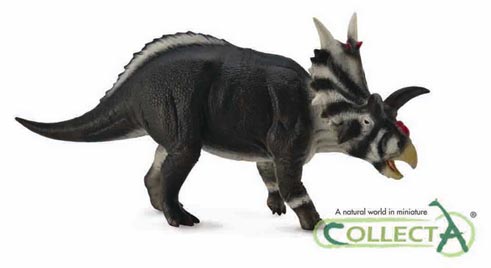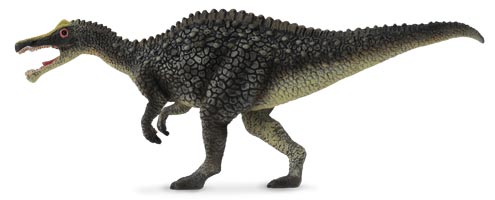A Mainly Monochrome Dinosaur Model – Clever CollectA!
With the release of the images of the CollectA Xenoceratops dinosaur model, this is an ideal time to discuss colouration on prehistoric animal replicas. This horned dinosaur, which should be available early in 2014, has striking and contrasting markings, providing an opportunity to consider the colour choices made by designers as they create prehistoric animal model figures.
Prehistoric Animal Model Colouration
The choice of colour for any model is extremely important for designers. They have to consider how the palette chosen might work with the shape and the texture of the figure. In addition, the right hue would draw the eye, even the absence of colour in some places can be used to create the right effect adding authenticity to their handiwork. Colours can convey mood and emotions, great care is taken when it comes to selecting the right colour chart to use with any CollectA figure.
One of the problems with painting dinosaurs, is that with no living non-avian dinosaurs around today, it is very hard for the designer to balance the need for a sense of realism and scientific accuracy with a creative licence. Some preserved feathers from small theropod dinosaurs have provided hints as to feather colouration, but scale pigmentation is unknown in the Dinosauria fossil record.
The CollectA Xenoceratops Dinosaur Model
Picture credit: CollectA
Colour Vision in the Dinosauria
Team members at Everything Dinosaur have been lucky enough to work with a lot of tyrannosaur skull material. When endocasts of the brain cavity are made it can be deduced that a significant proportion of a tyrannosaur’s brain is dedicated to processing information from the optic nerve (large optic lobes). The exit from the brain case for the optic nerve in an adult T. rex in some specimens we have seen, can be nearly 20 mm in diameter.
This suggests that a mature Tyrannosaurus rex had an optic nerve running from its eye into the brain that was thicker than my thumb! This evidence, combined with the position of the orbits (eye sockets) on the skull permitting stereoscopic vision and that the head was held upwards of fourteen feet off the ground suggests that big theropod dinosaurs had excellent vision. There is also a substantial amount of data available to suggest that other lizard-hipped dinosaurs and those from the ornithischian Order, (dinosaurs such as Xenoceratops), also had excellent eyesight.
Could They See in Colour?
But could they see in colour?
As primates, our vision is very different from the majority of mammals where colour vision is in most genera somewhat limited. Dogs for example, may have an extremely well developed sense of smell, but they see the world very differently from us. For many years, scientists thought that dogs could only see in black and white. We now know, thanks to a recent Russian study, that dogs can see in colour, although they lack the ability to perceive greens and reds in the same way that we do. Dogs have dichromatic colour perception, they have only two types of colour interpreting cone cells in their retinas, we primates have three.
Great Sense of Smell but Dogs See the World Differently
The brightness of objects and the degree of contrast that most mammals can see differs from our own vision, but when we look at the closest living relatives of the dinosaurs, the birds and the crocodiles a different picture (literally), emerges. Birds and crocodiles have excellent colour vision.
Studying Dinosaur Skulls
Based on the anatomical evidence from dinosaur skulls and comparative studies taken on extant relatives of the Dinosauria, most palaeontologists agree that colour vision came as standard amongst the dinosaurs array of highly developed senses. After all, our mammalian ancestors were creatures of the undergrowth or most probably nocturnal, niches taken up to avoid being eaten by the keen-sighted, largely diurnal dinosaurs.
CollectA Xenoceratops
So why have CollectA opted to give their new Xenoceratops model a paint job based mainly around white, or the absence of colour, what is termed black?
Oscar Wilde, the Irish poet, wit and writer stated:
“Mere colour, unspoiled by meaning, and unallied with definite form, can speak to the soul in a thousand different ways”.
He had a point to make when it comes to the colour scheme chosen for Xenoceratops. Not bad, when you consider that Mr Wilde died only a few years after the very first types of horned dinosaur were described by scientists. For Wilde and other late 19th Century writers, they would have been aware of the dinosaur discoveries both in Europe and those reported by Cope and Marsh from the United States, but they most certainly could not have imagined the diversity and the variance in the ceratopsids that we know today.
Predominantly Black Colouration
The predominantly black colouration on the body, the limbs and on the tail of Xenoceratops conveys power and strength. In western cultures, black is strongly linked to foreboding, menace, power, death and ferocity. Depicting this 2,000 kilogramme, horned herbivore largely in black conveys an impression of invulnerability to CollectA’s latest horned dinosaur figure. Those long, black brow horns, do indeed look very menacing. Tyrannosaurids around in what was to become southern Alberta (Canada), approximately 80 million years ago would have thought twice before they took on one of these plant-eaters.
The body colouration contrasts starkly with the white rump bristles, the banding on the forelimbs and the flashes of white on the skull and the immense neck frill. Whilst no one can be certain, such bold use of black and white would permit the head to stand out markedly from the surrounding vegetation and the dark bodies of herd mates. Such a set of markings on the head would provide the animal with a very powerful visual signalling device, ideal for intraspecific combat to help settle disputes amongst rivals as well as offering any predator brave enough to confront a mature individual, a frightening visual threat display.
A Close of the Head of Xenoceratops
Picture credit: CollectA
Facial Features
The shelf of bone over the naris (nose) has been coloured red. This would have made this bony lump clearly visible against the black and white facial markings. Palaeontologists are unsure as to whether this lump was the base of a large horn comprised of keratin, which has not been preserved in the fossil record. Other related, later centrosaurines from North America share this bony characteristic, animals such as Pachyrhinosaurus and Achelousaurus. CollectA have also made not to scale models of these two dinosaurs as well.
The fossils of Xenoceratops (the name means “alien horned face”), have been found in southern Alberta. Although this part of the world was much warmer in the Cretaceous than it is today, the land where Xenoceratops roamed would still have been at a high latitude. It would have been cold, not as cold as Alberta today but certainly chilly for a significant proportion of each year. A large black body would have helped this animal maintain its body temperature as black colouration absorbs heat.
Perhaps the designer at CollectA envisaged a Middle Campanian scene in which vast herds of Xenoceratops turn their stocky bodies to face the early morning sun, so that the sun’s rays can help warm these dinosaurs up. Dark colouration in combination with a covering of fine, feathery bristles would have helped these heavy dinosaurs keep warm, it’s a thought.
Irritator challengeri
CollectA have coloured one of the earlier models almost entirely black. It was a model of the South American spinosaurid Irritator (Irritator challengeri).
The Irritator Dinosaur Model (CollectA)
Picture credit: CollectA
Everything Dinosaur team members wrote an article about this fish-eating dinosaur and proposed a reason for its dark colouration, to read the article:
Why is the Irritator Dinosaur Model Painted Black?
A spokesperson from Everything Dinosaur commented:
“Colour can convey a lot of subtle information when it comes to considering the markings and patterns seen on a dinosaur model. Manufacturers are looking to convey realism and use colour to help interpret fossil material in such a way as to permit animal behaviours to be inferred. The CollectA Xenoceratops model certain stands out visually and it is clear that a lot of thought and care has gone into selecting the colour scheme.”
Looks like 2014 is going to a busy year for sales of CollectA dinosaur models, the evidence is there for all to see, after all its in black and white.
To see the CollectA prehistoric animal model range: CollectA Prehistoric Life models.










As a confirmed fan of Ceratopsians I welcome all models of new genera. This looks good and I’m sure it will be a very popular addition to the collections of many enthusiasts. However, for me personally it doesn’t quite “do it”. Perhaps because it is very similar to several other existing types. I had hoped to see Einiosaurus next year and would also like to see an updated Styracosaurus.